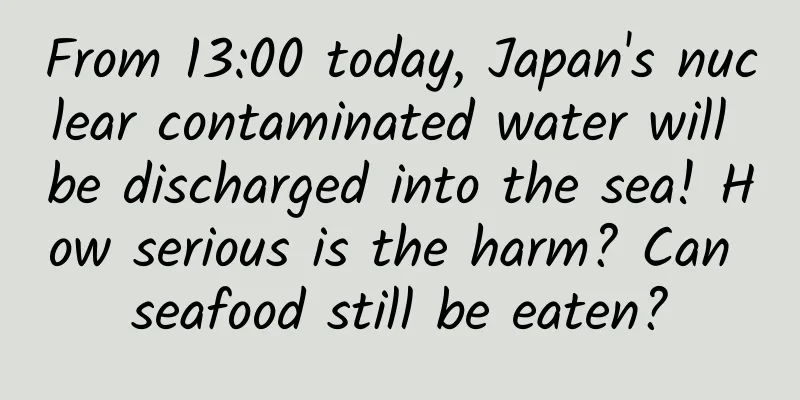From 13:00 today, Japan's nuclear contaminated water will be discharged into the sea! How serious is the harm? Can seafood still be eaten?

|
According to CCTV News, Tokyo Electric Power Company said it has sampled and tested the contaminated water to be discharged into the ocean, and the concentration of tritium "met the standard". If weather conditions permit, the discharge of contaminated water from the Fukushima Daiichi Nuclear Power Plant into the ocean will start at 13:00 local time (12:00 noon Beijing time today). At around 10 a.m. local time on the 24th (around 9 a.m. Beijing time), Tokyo Electric Power Company held an emergency press conference on the discharge of nuclear contaminated water from the Fukushima Daiichi Nuclear Power Plant into the sea and announced that today's discharge of nuclear contaminated water is expected to be 200 to 210 tons, and the daily discharge situation will be announced the next day. The first discharge into the sea will discharge about 460 tons per day, and the first discharge into the sea will discharge about 460 tons per day for 17 days, with a total discharge of about 7,800 cubic meters of nuclear contaminated water. The practice of forcing the discharge of nuclear contaminated water into the sea has aroused doubts and opposition from many parties. Fukushima Daiichi Nuclear Power Plant Image source: Tokyo Electric Power Company 1. Where does the large amount of nuclear wastewater come from? What is in Japan's nuclear contaminated water? Where does this nuclear wastewater come from, and why does it continue to accumulate? How radioactive is the wastewater discharged into the ocean? To answer this question, we must first understand the structure of the Fukushima nuclear power plant. According to the original design, the Fukushima nuclear power plant has five levels of safety protection measures. The first layer is the fuel pill, which is a pill-shaped or cylindrical substance made by pressing high-concentration nuclear fuel using powder metallurgy technology and sintering it at high temperature. Through this process, the possibility of nuclear fuel leaking to the outside world after a nuclear reaction will be greatly reduced. The second layer is the fuel jacket, which uses a sleeve made of zirconium alloy to encapsulate 350 fuel pellets. The fuel pellets and fuel jacket together are what we often hear about as fuel rods. The third layer is the pressure vessel, which is a large steel tank with a thickness of 15 cm. It is also the most critical protective structure in the nuclear reactor. The fission reaction occurs here. The steam temperature generated after heating the water will reach 280 degrees Celsius and the pressure will reach 70 to 80 atmospheres. The fourth layer is the nuclear reactor containment, which is a reinforced concrete container with steel plates inside, and it is wrapped around the outside of the pressure vessel. The fifth and outermost layer is the reactor building, which is a square reinforced concrete structure with a wall thickness of about one meter. It can effectively prevent the radiation of alpha rays, beta rays and gamma rays to the outside world. Reactor safety agency, Source: China Science Expo In a normal nuclear power plant, radioactive materials cannot even break through the first layer of protection, namely the fuel pellets. However, in 2011, an earthquake occurred in the Pacific Ocean off northeastern Japan, triggering a tsunami. A large amount of water hit the Fukushima Nuclear Power Plant in Japan, which later caused an explosion. At that time, in order to cool the burned nuclear reactor, Tokyo Electric Power Company used a large amount of seawater to cool the nuclear reactor. In fact, more than 10,000 tons of contaminated seawater were discharged at that time. The contaminated water in Japan contains radioactive nuclides such as tritium, strontium-90, cesium-137, cobalt-60, and carbon-14, each of which has an impact on the natural environment and human health. In addition to cooling water, nearby groundwater also continues to enter the reactor building, causing the amount of contaminated water to increase further. Afterwards, Japan stored the polluted seawater in water tanks. Each water tank is 12.5 meters high, 12 meters in diameter, and has a capacity of about 1,220 cubic meters. A single water tank can store about 1,000 tons of water. From 2011 to 2023, Japan built more than 1,100 water tanks in 12 years. Each water tank can store an average of 1,000 to 1,300 tons of water. So far, the capacity of the water tanks has basically reached saturation. Storage tanks for nuclear wastewater in Fukushima, Japan. (Photo source: CCTV News) Is there no other solution to the large amount of polluted cooling water except discharging it into the ocean? From a scientific point of view, there are many ways to dispose of nuclear waste. There are two ways to deal with high-level radioactive nuclear waste internationally. One is to directly put the spent nuclear fuel into large cans after processing and bury them deep underground. Countries with vast territories such as the United States, Russia, Canada, and Australia currently do this. The other is to drop metal cans filled with nuclear waste into the seabed 4,000 meters below the selected sea area. China's treatment of high-level radioactive waste is similar to the first method: first send the spent fuel to the disposal site for glass solidification, and then bury it in a layer at least 500 meters deep. Therefore, Japan can also solidify the water tanks filled with nuclear wastewater and bury them deep underground. The hydrogen/steam release method can also be used, that is, the nuclear waste water is electrolyzed to turn into hydrogen and oxygen, or heated at high temperature to turn into water vapor, and then discharged into the atmosphere. In the report released by the Japanese government expert group, five plans were proposed, including injection into the formation, discharge into the ocean, steam emission, electrolysis release, and solidification landfill. But in the end, Japan chose to discharge the nuclear contaminated water through submarine pipelines because other methods require very high technical content and cost, while discharging it into the ocean is the least expensive. Although Japan insists on calling the nuclear contaminated water treated by the "ALPS" as "treated water" and believes that the so-called "treated water" has met the standards for discharge, the international community has always had doubts about the safety, effectiveness and sustainability of Fukushima's nuclear contaminated water treatment equipment. On August 22, Japanese citizens held an emergency rally in front of the Prime Minister's residence in Tokyo to protest the government's disregard of public opinion and the release of nuclear contaminated water into the sea. Image source: Xinhua News Agency 2. What impacts will the discharge of nuclear contaminated water into the sea bring? Once the nuclear contaminated water is discharged into the sea, it will not only pollute the waters near Fukushima, but will also affect the waters of neighboring countries and even have an adverse impact on the global marine ecological environment. First, the Pacific coast of Japan will be affected, especially the local waters around Fukushima Prefecture. The sewage will then pollute the East China Sea. In addition, it will continue to spread through the marine ecosystem, such as the food chain, and it may also enter the human body through the public's intake of seafood, thus bringing certain potential impacts on the marine ecosystem or human health. Secondly, there is no effective treatment technology for many radioactive nuclides in nuclear contaminated water. The contaminated water from the Fukushima nuclear power plant contains more than 60 radioactive nuclides, such as tritium, carbon-14, and iodine-129. Many of these radioactive nuclides do not have effective treatment technologies, but Japan has been misleading that "the problem is only with tritium." In a 2020 investigation report titled "The Contaminated Water Crisis at the Fukushima Daiichi Nuclear Power Plant of Tokyo Electric Power Company," an international environmental organization pointed out that there is a high concentration of radioactive carbon-14 in the contaminated water, and ALPS was not designed to remove carbon-14. The author of the report, German researcher Sean Bernie, pointed out that Tokyo Electric Power Company did not admit the presence of carbon-14 in the so-called "treated water" until 2020. An investigation by an international environmental organization found that ALPS cannot remove radioactive tritium and carbon-14, nor can it completely remove other radioactive isotopes, such as strontium-90, iodine-129, and cobalt-60. Gao Zhiguo, president of the China Society of the Law of the Sea and former judge of the International Tribunal for the Law of the Sea, said that after these radionuclides enter the marine environment, tritium may not be the most dangerous. The most harmful to humans and marine life are carbon-14 and iodine-129. The half-life of carbon-14 is more than 5,000 years, and the half-life of iodine-129 is even longer. Carbon-14 will accumulate in the bodies of marine life, that is, fish, and the abundance or concentration of carbon-14 may be 50 times that of tritium. Third, the impact of nuclear contaminated water affects the entire world. German marine science research institutes pointed out that the coast of Fukushima has the strongest ocean currents in the world. Within 57 days from the date of discharge, radioactive materials will spread to most of the Pacific Ocean. Three years later, the United States and Canada on the other side of the Pacific Ocean will be affected by nuclear pollution, and in ten years it will spread to all oceans around the world. German marine science research simulates the spread speed and impact of nuclear contaminated water. As can be seen from the figure, radioactive materials will continue to spread over time and then spread to the world's oceans. Source: GEOMAR 3. Can we still eat imported seafood safely? Are Japanese cosmetics still safe? General Administration of Customs: Suspend the import of aquatic products originating from Japan Wu Wei, a professor at the Department of Biochemistry and Molecular Biology, School of Basic Medical Sciences, Capital Medical University, said that radioactive isotopes are volatile substances that not only pollute the ocean, but can also exist in the soil and air, so they will have a certain impact on agricultural products and daily necessities. In other words, whether it is food, skin care products, clothing, etc., in the long run, they will be affected to a certain extent. For the general public, it is recommended to purchase imported products that have passed the nuclear radiation residue test through regular domestic channels. On August 24, the General Administration of Customs issued an announcement on the complete suspension of imports of Japanese aquatic products: from now on, the import of Japanese aquatic products will be completely suspended. In addition, Japanese cosmetics also have a great influence in China. Industry insiders told the media that cosmetics should first be classified based on whether they use marine raw materials. Nuclear wastewater discharge may have an impact on raw materials from the ocean, such as seaweed and fish collagen. "In addition to cosmetic raw materials directly from the ocean, some radioactive elements may be enriched by marine organisms and brought into cosmetic raw materials." Public information shows that the Japanese government has not issued any policies and standards to force cosmetic factories to conduct radioactivity testing. After the earthquake, the Japan Cosmetics Industry Federation (an industry organization) issued a statement saying: "The radioactive substances released into the atmosphere by the Fukushima Daiichi nuclear power plant accident will not cause cosmetics to affect consumers' health." Some Japanese cosmetics companies have also added radioactivity concentration testing items for their products. According to the provisions of my country's Customs Law and Radioactive Pollution Prevention and Control Law, the customs shall carry out nuclear radiation monitoring on various customs supervision objects in accordance with the law to prevent the illegal entry and exit of radioactive materials. Today, the relevant person in charge of the Ministry of Ecology and Environment (National Nuclear Safety Administration) answered reporters' questions about Japan's launch of the discharge of Fukushima nuclear contaminated water into the sea and said that it is organizing the 2023 marine radiation environment monitoring of the sea areas under my country's jurisdiction. In the future, our ministry will continue to strengthen relevant monitoring work, timely track and judge the possible impact of the discharge of Fukushima nuclear contaminated water into the sea on our marine radiation environment, and effectively safeguard our national interests and people's health. Comprehensive sources: Xinhua News Agency, CCTV News, Beijing Daily, etc. |
<<: What is the difference between a 30 yuan kiwi and a 15 yuan kiwi? The answer is...
>>: I can't believe it! I actually support the CP of Gogou and Cheetah
Recommend
Online marketing activity planning
The APP online promotion activity planning progra...
Sunbathing on hot days is a trend all over the internet? Don’t blindly follow the trend if you don’t understand these things
What was the most exciting thing recently? That m...
It’s time to enjoy the spring, but don’t get angry!
As the weather gradually warms up, it is a good t...
Double Eleven express delivery has arrived one after another, the correct way to receive express delivery →
On November 13, the State Post Bureau issued a no...
Smart hardware is developing too fast, please wait for consumers!
2014 is coming to an end, and it is clear that in...
About the user growth system, an operation note you can't miss
My recent work requires me to study the user grow...
Is it better to exercise in the morning or at night? Scientists say it’s best to move first!
Recently, accompanied by the singing of "Com...
A good project to start a factory with a thousand yuan investment (investing several thousand yuan to open a rural laundry detergent processing factory), one person starts a factory with a thousand yuan investment
Hi everyone, we meet again. Thank you all for you...
Why do pigeons always bow their heads with each step when they walk? Won't they feel dizzy?
Review expert: Ran Hao, a well-known popular scie...
APP overseas promotion, detailed explanation of ASO skills!
For apps that are promoted overseas, the current ...
Weimei Weight Loss: What is the role of user tags on the website?
The recommendation system on the website has two ...
World Cycling Day丨The secret of balance in small wheels: you only need strength and you to make the bicycle run smoothly
Produced by: Science Popularization China Author:...
Query the investment price of Wuxi Preserved Fruit Mini Program. How much is the investment price of Wuxi Preserved Fruit Mini Program?
How much does it cost to invest in the Wuxi Candi...
Scientists have a new explanation for this "super confusing" phenomenon in the weight loss world →
For people who want to lose weight, the most frus...
How to create explosive content? Share this 7-word mantra!
Beautiful, exciting, cute, warm, awesome, fun, an...









